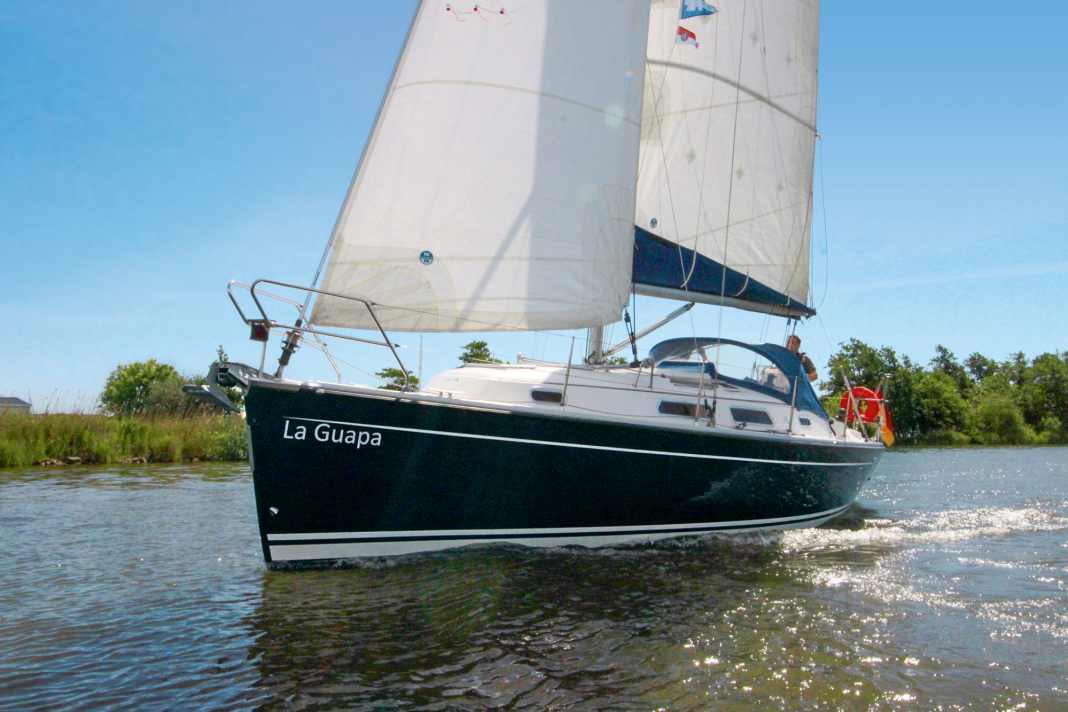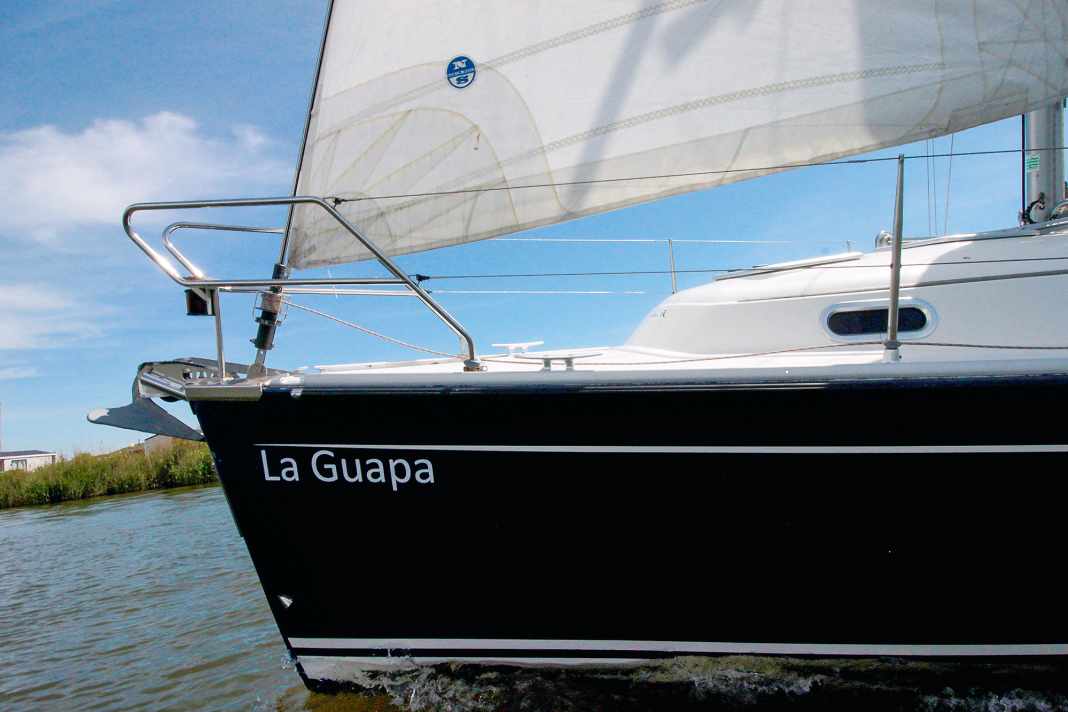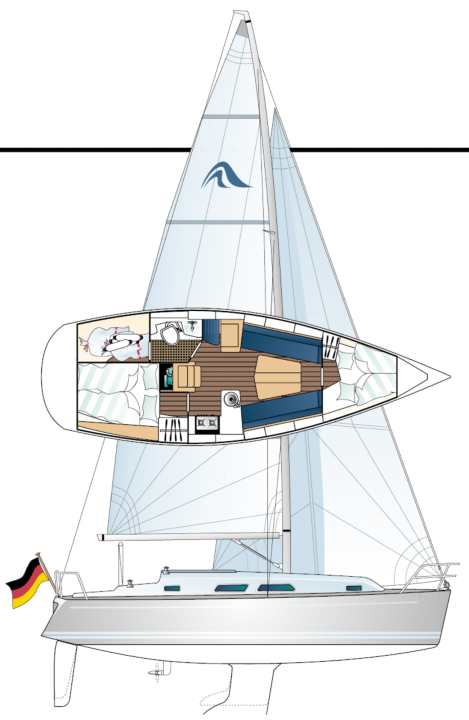





Finding a good compromise is undoubtedly an art. Sporty sailing characteristics require low weight, but this is often at the expense of living quality. A lot of living space, on the other hand, is heavy and can therefore only be properly manoeuvred with large sail areas. This means sacrificing ease of handling. An overly durable design is expensive, which makes the boats unaffordable for many. The Hanse 315 strikes the famous happy medium between cosiness, fun-filled sailing and neat construction.
Everything there for four
Below deck, the dimensions are comfortable, although not huge. The headroom of 1.80 metres in the foredeck and WC and 1.85 metres in the saloon is fine. The berths are actually quite large, certainly in the foredeck. The bed there even measures 2.30 metres in length. That's almost too much, as the aft berth is a few centimetres shorter than a comfortable length. Nevertheless, the bed fits the headroom. If you are not taller than 1.80 metres, a berth that is 1.90 metres long is sufficient.
The feeling of space is great. Although the dark wood creates a very nave-like atmosphere, this is brightened up by the white main bulkhead and the large windows with sufficient light. This is pleasing, cosy and reasonably timeless. The shipyard called it "New England style" at the time. Some models even still have wickerwork in the hatch doors. Although this ensures good ventilation, it is somewhat sensitive. The test boat has solid hatches.
Used boat profile of the Hanse 315
- Type: Hanse 315
- Design engineer: Judel/Vrolijk & Co
- Built: 2005-2007
- Quantity: 330
- New price ready to sail: 70.000 €
- Price today: 50.000 €
There is a small locker and the large berth described above in the foredeck. It is a full 1.60 metres wide at shoulder height. Enough space for two. Aft is a little tight, as the inner berth is only 30 centimetres high in the foot area. However, this only applies to the version with steering column and wheel. If a tiller is installed, there is more space. The width of the berth is fine at 1.50 metres.
The wet room is just as successful. It offers plenty of space, even for showering. In the saloon, four people sit comfortably around the large table. It can be folded to the side so that it is easy to get through to the foredeck. The Hanse's designers even found room for a real navigation station. However, this comes at the expense of the length of the saloon benches. 1.80 metres is enough for two people to sit on, but for many it is not enough to sleep on. Moreover, the width of 50 centimetres does not invite you to do so. However, you don't want to spend long periods of time with more than four people on board anyway. There is not enough space in the cockpit alone. No problem for a 31-footer.
Also interesting:
The galley is complete. Cupboards, cooker with oven, sink and fridge compartment - everything is there. The wooden surfaces have a dignified look and, together with the matt fittings, are almost elegant. You would like to spend some time here, not least because everything fits in terms of size. The passages are wide enough throughout, and the seats and backrests provide ergonomically comfortable seating.
There are a few details that are particularly pleasing: first and foremost the wet room. The passageway into the cockpit locker is practical to allow access to stowage items further down in the deep storage area. And a small, but still available clothes rail for wet oilskins answers the question: where to put them?
In the forward cabin, part of the berth area can be folded up. This creates a very comfortable cabin for single occupancy with seating and - almost more importantly - the option of getting dressed standing up in the cabin. The starboard berth is then still 75 centimetres wide. So much for the equipment below deck.
On the wind goes well
The wind is blowing at 10 to 14 knots during the test off Lemmer, ideal for the Hanseatic League. With a full sail, the yacht heads upwind through the narrow Friesland fairways. The yacht from Greifswald is very responsive at the helm. The wind edge is easy to find, and angles of well under 90 degrees are possible when tacking. A good 5 knots of speed is almost pleasing. The Hanse runs really well, also because of the folding prop on the saildrive.
The sail plan with self-tacking jib is typical of these boats. A real pleasure on a cruise, with virtually no work involved in tacking. Hanse advertised this very actively in the catalogue at the time: "A cruise with a Hanse becomes a luxurious cruise at sea." So far, so good. And then the copywriters orated at the time: "You promised your wife that a long time ago."
One thing is certainly true: Hanse has put an end to the days of huge headsails that could only be cranked tightly on small large-series winches with thick upper arms. This advantage comes at the price of two compromises: Firstly, the mainsail is correspondingly large and you have to know how to keep its power in check, and secondly, the self-tacking jib hardly works on courses deeper than 60 degrees to the wind.
While the main can be easily tamed with a little practice thanks to the strong backstay staysail, optional traveller, outhaul and downhaul, you have to invest in the headsail situation. You can either order the optional 140 per cent genoa package - which, however, brings with it the cranking problem downwind - or you can use a code zero or gennaker.
Gusts are acknowledged with pressure, the ship moves off
In any case, two additional winches in the cockpit are helpful. The platforms for this are already provided. If the gennaker is to be actively trimmed and the boat is being sailed with a tiller, then the person should ideally stand at the very aft end of the cockpit. This is not possible on the version with a wheel. There is not enough space. Regardless of whether you are turning or pushing: You need coloured cloth for the way to leeward, otherwise it's no fun.
The situation is different downwind: gusts are acknowledged with pressure and the boat sets off. If the gust prevails, a pull on the backstay helps, or the traveller moves to leeward and the pressure can be reduced to a desired level. This is just right for a sporty cruising yacht.
A steering wheel is installed on the test ship. Its movements are transferred to the quadrant via a rod. This works perfectly and without any play. If a traveller is installed, it divides the cockpit and no table can be attached to the steering column. However, the owner has found a retrofit solution for a table. However, it is stored in the large cockpit locker when not in use.
Tiller provides more legroom in the aft chamber of the Hanse 315
Keyword steering wheel: a tiller would certainly look good on the boat. It is agile and a lot of sailing power comes from the main. The helmsman can operate it easily when sitting on the high edge on the specially flattened coaming with the extension in his hand. The traveller and sheet are then perfectly within reach. The tiller also provides more legroom in the aft cabin and, when folded up, is virtually unobtrusive in the harbour.
There are also some nice details on deck: The rigging is continuous, so the shrouds can be trimmed from the deck. The gas locker is easily accessible, and two lockers to the side of the passageway to the bathing platform offer plenty of space in addition to the already large storage space on the port side. It could be a little better organised. Things quickly disappear into the depths.
The shallow anchor locker is not so good. The chain will quickly pile up behind an (optional) anchor windlass. Compromise: This is also the reason why the bunk in the foredeck can be so - almost unnecessarily - long.
For whom?
The Hanse 315 is like a VW Golf. It works well, has space for four and can also be a little sporty on the road if desired. It is also visually appealing without being particularly experimental. All of this also applies to the Hanse. Anyone looking for one should make sure that the hull-deck connection is still intact, plan to have the hull painted (if it is coloured and this has not already been done) and check the area around the keel for hairline cracks inside. This would be an indication of running aground damage. Otherwise, the usual suspects are waiting: The saildrive boot will often still be the first one, given the years of manufacture, and has therefore reached the end of its service life. The same applies to the standing rigging after 15 years.
Otherwise, the Hanse 315 is a very worthwhile alternative in the club of 40,000-euro second-hand yachts, precisely because it has achieved an excellent compromise.
Prospective buyers must pay attention to this





Model history
The 315 replaced the 312 in 2005 and was replaced by the 320 in 2007. During this time, the ship was built around 330 times. Examples with a tiller are rare. As was customary at Hanse, many ships were delivered with coloured gelcoats. The deep keel dominates the draught. 30 hp diesel as an option
Market situation
The ship costs from 50,000 euros second-hand. More or less depending on the equipment and condition. The boats are usually sold quickly, so if you see one you like, don't hesitate for long.
The Hanse 315 in detail

Technical data of the Hanse 315
- CE design category: A
- Torso length: 9,35 m
- Width: 3,20 m
- Draught/alternative: 1,75/1,40 m
- Weight: 4,3 t
- Ballast/proportion: 1,3 t/30 %
- Mainsail: 27,5 m2
- SW-Fock (100 %): 16 m2
- machine (Yanmar): 15 kW/21 hp
Hull and deck construction
Hull and deck glued and screwed together. Both built using the hand lay-up method, bulkheads laminated, ISO resins, balsa core
YACHT review of the Hanse 315
A typical large series ship. The berth lengths and headroom are just right, as are the sailing characteristics. Also suitable used for a stress-free time on the water. Especially recommended for families and older couples thanks to its easy handling.
Design and concept
- + Attractive exterior
- - Low prices at SW-Fock
Sailing performance and trim
- + Good feedback at the helm
- + Easy to operate
Living and finishing quality
- + Very spacious
- + Good usable bunks
Equipment and technology
- + Large baking box
- - Quality of the coloured gelcoat
The article first appeared in YACHT 21/2020 and has been updated for the online version.

